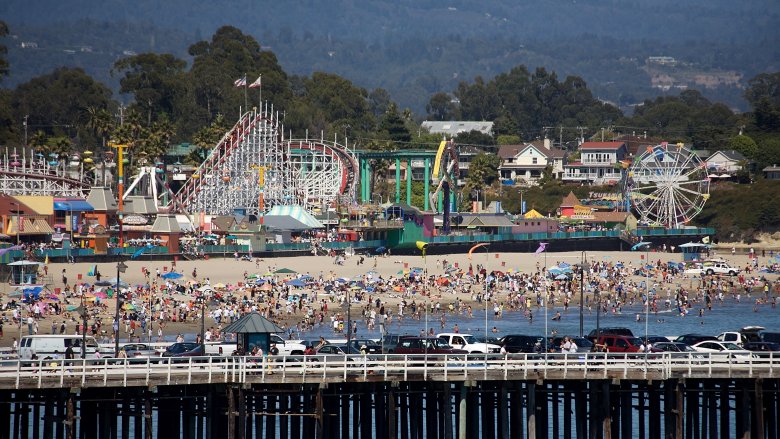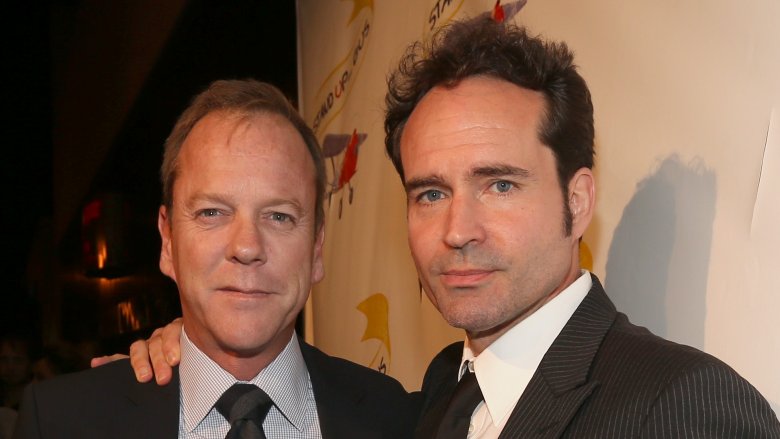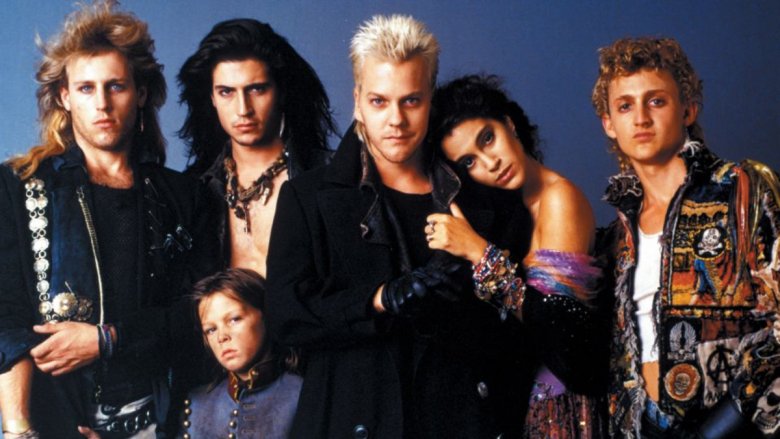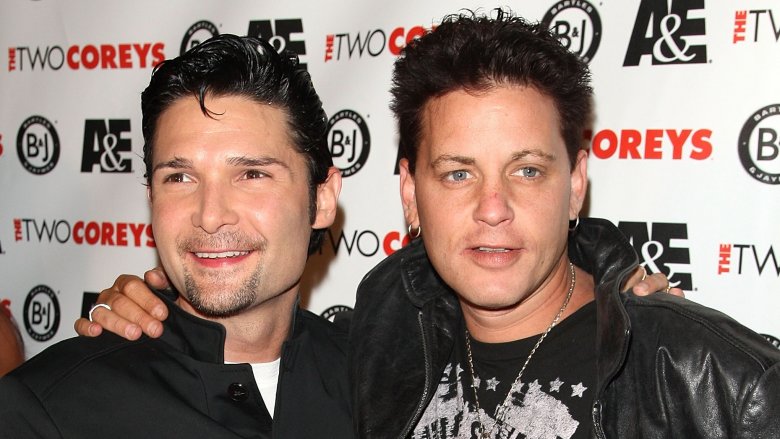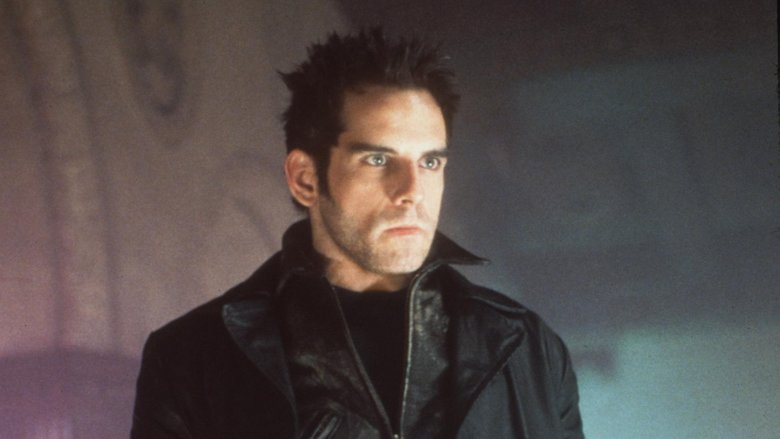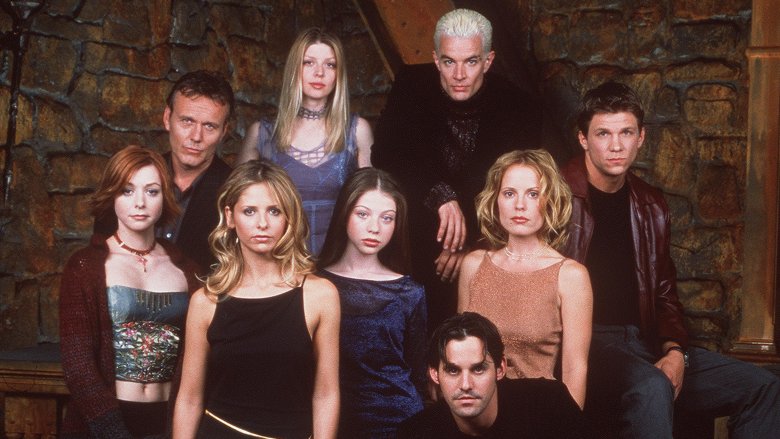The Untold Truth Of The Lost Boys
Following the success of St. Elmo's Fire, director Joel Schumacher took on a script for a wholesome, Peter Pan-inspired vampire movie called The Lost Boys—and turned it from a kid-friendly vampire hunt into a sexy, gory, and politically subversive teenage classic that changed the way vampires would be portrayed in Hollywood for decades to come.
While it still holds up as one of the better vampire films ever made, there's probably a lot you don't know about this cult classic. So grab your leather jacket, cruise down to the beach, and check out the untold truth of The Lost Boys.
Santa Carla doesn't exist... but Santa Cruz does
You don't have to be from California to know that Santa Carla, the town where The Lost Boys takes place, doesn't exist. However, locals can easily recognize The Lost Boys' location as the South Bay beach town Santa Cruz, thanks to shots of its Giant Dipper Roller Coaster.
Director Joel Schumacher fell in love with the locale as soon as he scouted it. "The movie didn't come together until I saw [Santa Cruz]," he told the Santa Cruz Sentinel. "At the time, there was an enormous amount of transient kids moving through Santa Cruz. This is exactly where I would come if I was a teenage vampire." After reversing a couple of letters in nearby Santa Clara, he even had a locally inspired new name for his movie's dream spot.
The cast enjoyed filming in the scenic beach town, too. "We had such a great time there," actor Corey Feldman recalled. "Being kids and having the opportunity to be at the Boardwalk every day, getting to ride on the Giant Dipper and being at the beach, it was such a fun experience."
However, securing Santa Cruz as the film's location wasn't all smooth sailing. The town's authorities were wary of the Boardwalk being portrayed in a bad light, especially after 1983's violent Sudden Impact—filmed partially in Santa Cruz—took them by surprise. Even worse, Santa Carla's title as "the murder capital of the world" wasn't fictional, as Santa Cruz earned that moniker after years of serial killings. But the authorities read The Lost Boys' script, loved it, and ended up giving Schumacher the green light.
Patric stole Sutherland's fiancée
While filming The Lost Boys, Jason Patric and Kiefer Sutherland became close friends. Four years later, however, Patric was on an airplane to Ireland with Sutherland's ex-fiancée, Julia Roberts, leading to some juicy tabloid drama.
"We were all going through very dynamic changes in our lives," Sutherland explained during his Jess Cagle Interview, "and then I obviously met Julia ... I fell very much in love with her. It was kind of, again, very much like Lost Boys. It was a really exciting time in my life." The power couple's wedding, however, garnered more media attention than Roberts would have liked. "It wasn't what she wanted to do in the end," Sutherland said. "I think it took a lot of courage, even amongst all of that other stuff, to be able to say, 'I can't do this.'"
Roberts then started dating Patric, who has since downplayed the whole love triangle ordeal. He's claimed the tabloid stories of Roberts running away with him were "all fake and bulls—" and told Vulture, "I was with her for a little while and it ended ... But [Sutherland and I] never had any issue, even back then."
Patric still hates the tabloid gossip surrounding celebrity relationships. "They honestly think we care about Brangelina? We don't. Not just me, nobody cares. No. Body. Cares."
Schumacher didn't want 'The Goonies go vampire'
The Lost Boys was initially skewed towards a much younger audience. The film's original script, written by Jan Fischer and James Jeremias, was intended to be—as the title suggests—a re-imagining of Peter Pan with vampires. However, as Schumacher told the Telegraph, he thought it read too much like "The Goonies go vampire," especially with Goonies director Richard Donner originally at the helm and Corey Feldman joining the cast.
When Donner departed to direct Lethal Weapon, Schumacher gained control and took The Lost Boys from "very wholesome" to very campy. "The Frog brothers were Boy Scouts," he explained. "I thought, 'Why can't they all be teenagers? Why can't they be dressed incredibly? And why can't they have stripped-down motorcycles that look skeletal?'" Schumacher posed these questions to Warner Bros. president Mark Canton, who ultimately gave him permission to give the script a teenage makeover.
Alex Winter, who played Marko, praised the changes. "I don't think I really connected with it until I got there and realized quite how deep Joel was going," he admitted. "He really got it cinematically and was taking it to this crazy place."
A Tale of Two Coreys, Chapter 1
Child stars Corey Haim and Corey Feldman were a late '80s dynamic duo, appearing together in License to Drive and Dream a Little Dream, as well as early-'90s direct-to-video releases Blown Away, National Lampoon's Last Resort, and Dream a Little Dream 2. But it was The Lost Boys that first paired the young actors who'd later be referred to as "the two Coreys."
Haim suggested on Larry King Live that their success as a duo boiled down to their natural chemistry. "We just clicked," he told King. "And people, I guess, get wind of it. Like, wow, these two have something off camera, but on camera ... we can complete each other's sentences."
Feldman agreed, telling King, "I've worked with a lot of great people through the years. And with Corey, you know, you set us in front of a camera and tell us to go and it just happens. And there's really no explaining that, you know?"
Unfortunately, a series of ill-advised personal and professional decisions derailed both Coreys' careers, and their brief peak as teenage heartthrobs presaged a slew of direct-to-video releases, both together and apart, during the '90s and beyond. Reuniting with Feldman on the short-lived reality show The Two Coreys couldn't save Haim, who passed away in 2010 at the age of 38.
Ben Stiller, Lost Boy?
Kiefer Sutherland's crew of leather-wearing teenage vampires with rock 'n' roll haircuts was undoubtedly sexy—cast members Brooke McCarter and Billy Wirth actually started out as models—but could you imagine if they were graced by the presence of the world's most famous male model? Of course, we're talking about the one and only Derek Zoolander.
Ben Stiller, the man behind that ridiculous character, has claimed that he himself was almost a Lost Boy. According to People, Stiller recalled missing out on a spot in the film at the 12th Annual HollywoodLife Young Hollywood Awards. "Last time I saw a room full of so many talented faces was when I auditioned for The Lost Boys," he told the crowd. "It was between me and Kiefer and the two Coreys."
Of course, it's entirely possible that Stiller could've been joking. However, the actor would've been 21 in the summer of 1987, when The Lost Boys debuted, making him the perfect age. It's also easy to imagine the dark-haired Stiller wearing leather and riding a motorcycle alongside Sutherland and crew. Sadly, Stiller is most certainly not in the film, so we can only speculate how Zoolander's patented "Blue Steel" would've stacked up against McCarter's tough-guy smirk.
Buffy borrowed a bit
As one of the first teenage vampire films to feature some serious sex appeal, The Lost Boys inspired a whole new sub-genre of vampire stories—including Buffy the Vampire Slayer.
Buffy creator Joss Whedon has gone on record with some of the ways his show took inspiration from the film—like "the idea of [vampires] looking like monsters and then looking like people." As Whedon told Salon, "That was in Lost Boys, and that was very useful for us. ... You could have somebody fool you, or someone like Angel seem like he's not a vampire and then he is one."
The series' second season introduced a character named Spike, a platinum blonde vampire played by James Martsers. Whedon credited the film for the inspiration, telling Slayage.com that "there's a little Billy Idol, a little Kiefer Sutherland in The Lost Boys, and every guy in a black coat." The hair might've been a bit much, though. "I really thought the peroxide would define his face better," Whedon admitted, "though James does curse my name for the burning scalp."
Edgar Rambo
Thanks to his connection with Goonies director Richard Donner, Corey Feldman received an invitation to audition for the part of The Lost Boys' vampire-slaying Edgar Frog. But when he read through the script with Joel Schumacher, he was asked to "butch it up a little bit."
"[Schumacher] gave me an order," Feldman recalls in The Lost Boys: A Retrospective, "to go out and rent all the Stallone movies and all the Chuck Norris movies, like Rambo and First Blood and Missing in Action, all those kinds of movies. He said, 'that is your character. I want you to meld all of these guys together, and make something out of it.'"
Feldman's portrayal of Edgar Frog certainly breathes some comedic life into the film, which is often rather dark and serious. "I think the fun part about the character and the comic value of it," Feldman says, "is that he doesn't think it's funny, and he's not in on the joke. So, [he's] one of those people that you just kinda have to laugh at because, you know, they really take themselves very seriously, and they believe every word of what they're saying about themselves, or whatever it is they believe in."
It challenged conservative notions of family
The Lost Boys may be campy, but it challenged stereotypes of family life in some surprising ways.
The Atlantic argues that the movie arrived at a time when many Americans were fearful of a perceived disintegration of the traditional nuclear family structure. A new wave of conservatism had taken hold, with Jerry Falwell's Moral Majority grabbing headlines and Ronald Reagan deep into his second term.
The Lost Boys challenged these notions by focusing on two non-traditional families—the Emersons and the vampire crew. As 'the good guys,' the Emersons survive—and ultimately thrive—despite the mother being newly divorced, broke, jobless, and forced to move into her father's house with her two sons, one of whom stays out all night partying with a bunch of murderous bloodsuckers. When Max, the one father-type character who could potentially "fix" the broken Emerson family, steps in, it turns out he's also a monster. Meanwhile, the film's other family is a bunch of dudes living, sleeping, partying and killing together.
Schumacher himself even endorses this analysis, telling GamesRadar that "[The Lost Boys] is, in a way, about the fear we have of the Other—those who live outside of the mainstream."
It also challenged conservative notions of sexuality
The Lost Boys is also commonly analyzed as challenging conservative notions of sexuality—at a time when the President of the United States was accused of ignoring the country's incredibly serious AIDS crisis.
Today, much of The Lost Boys is commonly viewed as homoerotic. Santa Carla itself represents a place where people on the outskirts of society, such as homosexuals and vampires, can live openly. David and his crew of vampires dress in leather outfits not dissimilar to those worn by members of the early '80's underground gay club scene, and new vampires must drink David's blood in an initiation ceremony. Sam's bedroom is decorated with a poster of Rob Lowe which shows the heartthrob's muscular abs. Michael, fearing his bi-curious actions have led him down a deviant path, rushes off to have sex with Star—whom none of the other vampires seem particularly interested in.
It's all about Michael
Anyone who's ever even passively watched The Lost Boys has the name "Michael" permanently engraved in their memories of the movie. And how could they not? The protagonist's name is uttered more than any other word in the entire film.
Just how many times do we hear his name? Thanks to Vimeo uploader @TURBOCLAW, we now have an almost definitive count of how often "Michael" is uttered during The Lost Boys: 114 times... give or take.
But is 114 Michaels really a lot of Michaels, you ask? Well, consider that the film's runtime is 97 minutes, leaving viewers with nearly 1.18 Michaels per minute. That's a lot. Throw in the fact that the film's not exactly dripping with memorable dialogue, and it becomes clear that the half-vampire's name takes up the lion's share of the script.
The 'Sexy Sax Man' is legit
In a few of The Lost Boys' most iconic moments, American musician Timmy Cappello belts out a raucous rendition of the Call's "I Still Believe" to an enthusiastic crowd of Santa Carlans. Famous for being absolutely jacked, showing off a lot of skin, and suggestively thrusting his hips while wailing on the saxophone, Cappello's career extended well beyond that scene—he was, and still is, a well-respected musician who's worked with the likes of Eric Carmen, Peter Gabriel and Carly Simon. He also toured with the one and only Tina Turner for 15 years, and also did a couple of tours with Ringo Starr's All-Starr Band.
Still, Cappello will always be most famous for his few minutes in The Lost Boys, which even Saturday Night Live has parodied. "When I go somewhere," he told Icon vs. Icon, "no one ever says, 'Oh, you're the guy from Tina Turner's band!' Nope. It's always The Lost Boys." He finds that fact funny, too, given that it only took two hours to film that scene. "You work so hard," he said, "and the thing you get known for is so much smaller."
It has sequels, and they're awful
You never realized The Lost Boys had sequels? Consider yourself lucky.
More than 20 years after its premiere, The Lost Boys received its first sequel. Titled The Lost Boys: The Tribe, the direct-to-DVD movie brought back Corey Feldman as the only original cast member, and while it features plenty of vampires and topless women, it has almost nothing to do with the original film, leading critics to unanimously label it as little more than a cheap cash grab.
And grab cash it did, more than covering its production costs in only a matter of weeks. Given the financial success of the sequel, Warner Bros. did what most major studios would do, and gave the go-ahead to make another. The third installment, titled The Lost Boys: The Thirst, relied almost entirely on Feldman to carry the movie—and his performance is the film's highlight.
Sadly, that isn't saying much—The Lost Boys: The Tribe and The Lost Boys: The Thirst both currently hold a 0 percent on Rotten Tomatoes. Let's all go on pretending they don't exist, shall we?
'Cry Little Sister' is a rapper's delight
The Lost Boys has long been associated with its gothic darkwave theme "Cry Little Sister." Written by Gerard McMahon, the song has enjoyed the same longevity as the film, covered by various artists for decades. L.A. Guns recorded it for their 2009 album Covered in Guns, and the track has also been tackled by White Noon, Mystic Circle, Carfax Abbey, Seven Icons, Aiden, Knives and Gasoline, and Tangerine Dream, among others.
And rock bands aren't the only ones interested in The Lost Boys' theme: Eminem sampled the track on his song "You're Never Over," and Lil B, Joe Budden, Mobb Deep, Snoop Dogg, Jim Jones, Tyga and Lil Wayne have also all laid down some bars over the soundtrack anthem.
